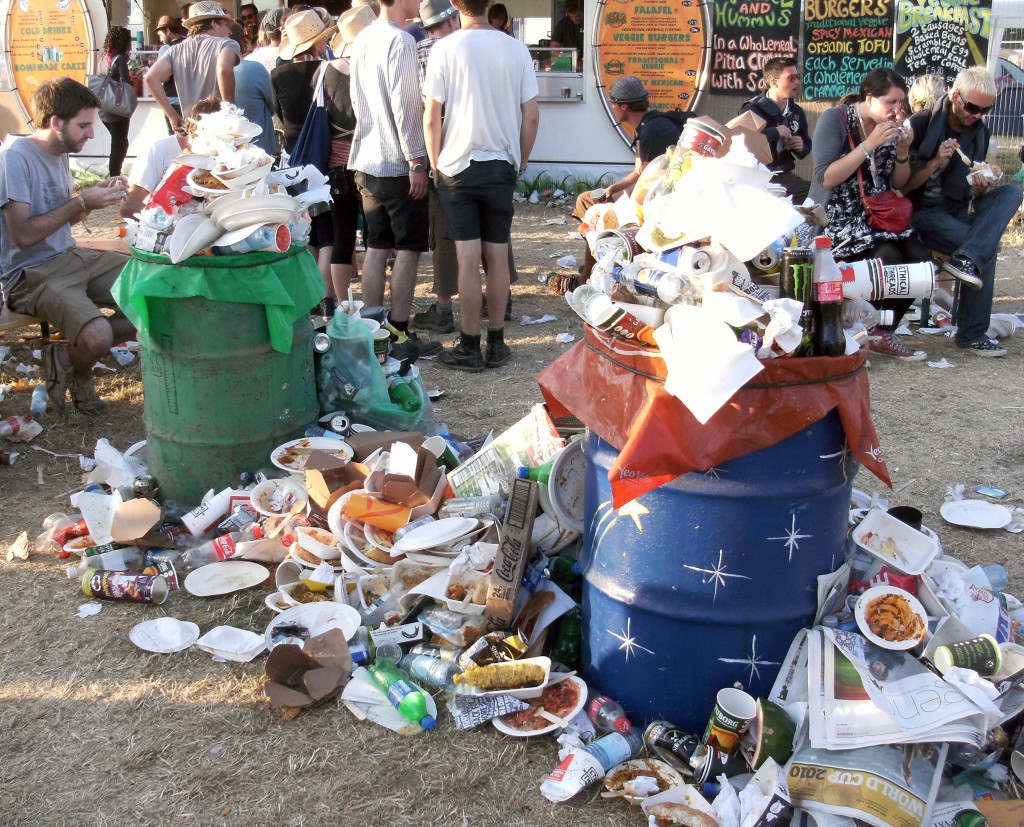Summer is here in the UK, and for some of us this means only one thing: festival season is upon us. Music festivals (and others) grow in popularity year on year, and new additions to the circuit get added frequently. We can’t seem to get enough of live music in fields!
Glastonbury Festival started out in 1970 as a festival created under the ethos of hippie counterculture – peace, love and green living. However, is Glastonbury environmentally friendly now? Are any mainstream festivals actually ‘green’? Also, how are festivals going about tackling their litter and environmental problems?
Environmental Problems

The main challenges festivals face when it comes to keeping it green are:
- Litter (including abandoned tents)
- Transport
- Water
- Toilets
- Energy
- Wildlife
Essentially, festival-goers are living in a temporary town/city for a weekend, and so with that comes all the environmental problems a real town would face when overcrowded; lots of litter, danger to wildlife, and high carbon emissions. Plus others, including people toileting where they shouldn’t. Glastonbury in the 1990s became a hazard to fish in the nearby river due to urine-induced high ammonia levels (due to people peeing on the ground). The organisers have, of course, since added many, many more toilets, including lots of compost loos.
The Glastonbury 2015 Clean-Up
Glastonbury 2015 involved a clean-up operation requiring 800 voluntary litter-pickers to collect and sort 1650 tonnes of waste. The entire clean-up cost around £780,000. This waste included 5000 abandoned tents, 9 tonnes of glass, 54 tonnes of plastic bottles & cans, and 41 tonnes of cardboard.
135,000 people on one farm results in quite a lot of waste, and way too much litter! Glastonbury does, however, skip a year every 5 years, to give the natural environment time to recover and replenish from the crowds and their effects.
Dealing With The Problem
Each large festival seems to have their own approach to dealing with green issues, and all appear to be trying – albeit, some a lot more than others.
Energy Supplies

Most festivals now seem to be aware of their overall carbon footprint and how that is impacted upon by the thousands of people travelling to and from their site. In fact, 68% of the total emissions caused by the average festival come from this travel. To combat this, festivals now promote car-sharing schemes, and the use of public transport. Also, bicycles are suggested, although I imagine that’s not as handy for carrying your tent etc.!
Glastonbury, for one, rewards those revellers who use public transport.
Litter and Water

Leeds and Reading Festival run schemes which encourage people to collect litter or at least bin their own; there’s a 10p cup and water bottle deposit, and collecting a bag full of cans equals 1 free beer at the recycling exchange.
Festivals such as Beat-Herder and Blissfields take a £5 refundable litter bond from attendees, who are expected to collect 1 full bag of rubbish during their stay.
Many festivals have cut down on the use of plastics and some, such as Shambala, have done away with plastic bottles completely – encouraging people to re-use one they bring with them instead.
T In The Park organisers – frustrated at the litter problem, and in particular the abandoned tent issue – launched a huge campaign and asked fashion designer, Iona Crawford, to make a dress from discarded festival tents. This highlighted the problem of discarded tents, and promoted alternative uses for damaged tents if people took them home.
Inherently Green Festivals

Of course, Green Gathering is, as the name suggests, a sustainable festival which is powered entirely by renewable energy; the stages are solar, and wind power is also used. They even run workshops on how to create renewable energy at home, and have speakers from the environmental movement too.
If Green Gathering can manage it, surely the others can follow suit in time? If some go back to their roots, they may rediscover their environmentally friendly ethos and potential solutions.
Resources:
Featured image credit: Pixabay

FYI about interactive public stages made from recycled speakers
http://www.benoitmaubrey.com/?p=2806